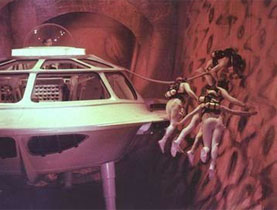Swiss build “Fantastic Voyage” micro-robot

Swiss scientists have developed a tiny corkscrew-shaped micro-robot that could be used to repair damaged human arteries.
The bacteria-sized robot, built by researchers at the Federal Institute of Technology in Zurich, is able to swim through liquids with great precision using external low magnetic fields, the institute’s online magazine ETH Life has revealed.
The Zurich team’s micro-robot is part of growing new research worldwide into small medical robots for sensing, drug delivery or surgery inside the human body.
The miniature device measures between 25-60 micrometres in length (a human hair is around 100 micrometres in diameter), compared with 5-15 micrometres for bacteria.
The “Artificial Bacterial Flagella”, which took five years to develop, has been inspired by nature.
“It’s basically a small corkscrew similar in size and shape to the flagella – the little tail on certain bacteria like E. coli that use them to propel themselves,” Bradley Nelson, professor of Robotics and Intelligent Systems at the Federal Insitute of Technology in Zürich, told swissinfo.
Interacting with the physical world totally changes when working at such a tiny scale, he added.
“If you made yourself ten thousand times smaller, water would feel like molasses,” said Nelson. “If you had a paddle that just went back and forwards you would go nowhere, so you need a corkscrew.”
Power problems
The mini-robot is built from fine layers of indium, gallium, arsenic and chrome, with its “head” made of chrome, nickel and gold.
As nickel is slightly magnetic, the robot can be moved in low magnetic fields up to a speed of 20 micrometres per second.
Powering tiny medical robots is a big issue at this scale. Research is currently focusing on how devices gather and store energy.
Nelson and his team believe the corkscrew shape offers many advantages.
“By mimicking the way bacteria propel themselves, we can guide and control similar-sized structures with very low fields so that we can control them from distance – several centimetres,” he said.
Practical applications
The tiny device is still at the stage of fundamental research. But in the future the minute machines could be used to travel to otherwise inaccessible regions to precisely deliver drugs or to manipulate cells or molecules, say the Zurich researchers.
The team is currently testing new materials and control mechanisms, and examining how best to track the device.
“It’s one thing under a microscope, but another thing when it’s inside a body,” said Nelson.
Tests in humans are not foreseeable right now.
“But I don’t think there is any fundamental science that limits us,” he said. “It’ll take people with a grand vision, a lot of energy and the resources. The stronger each of those are, the quicker it will come.”
Gathering pace
But in recent years there has been significant progress in developing small medical robots. The most clinically advanced devices, like the “Pillcam” – a one-centimetre-wide camera-equipped capsule that can be swallowed, focus on the human gastrointestinal tract, as it is easily accessible and can accommodate small objects.
The Israeli-developed capsule robot, which takes and sends pictures as it moves naturally through the intestine, has become widely used since it was introduced in 2001.
The new corkscrew-shaped micro-robot is the tiniest of three devices that have been developed by the Robotics and Intelligent Systems team.
Scientists in Zurich are also working on ways of applying external magnetic fields to steer one-millimetre-long robots inside the human eye for sensing, drug delivery and surgery. Using a micro-robot might allow eye surgeons to use only a mild anaesthic and no stitches, and to deliver drugs directly to veins inside the retina.
But research into medical micro-robots is gathering pace elsewhere. In Australia scientists from Monash University near Melbourne are building a similar flagella-like micro motor that could propel a micro-robot.
And in 2007 a research team from the Ecole Polytechnique de Montréal in Canada made the voyage from fiction to reality possible when it successfully moved and controlled a 1.5-millimetre magnetic bead through a living pig’s artery. They have since reduced the bead’s size to about 250 micrometres.
swissinfo, Simon Bradley
Bradley Nelson is the Professor of Robotics and Intelligent Systems at Federal Insitute of Technology in Zürich.
His primary research involves extending robotics research into emerging areas of science and engineering, and his main research topics are in microrobotics and nanorobotics.
Nelson has a Masters in Mechanical Engineering from the University of Minnesota and a PhD in Robotics from Carnegie Mellon University.
His Zurich lab won the 2007 RoboCup Nanogram Competition, the first year the event was held.
In the 1966 science fiction film “Fantastic Voyage” the United States and the Soviet Union have both developed technology that allows matter to be miniaturized using a process that shrinks individual atoms.
But its value is limited because shrunk objects return to their normal size after a period of time – the smaller an object, the quicker it reverts to normal.
Scientist Jan Benes, working behind the Iron Curtain, has worked out how to make the shrinking process work indefinitely. With the help of the CIA, he escapes to the West, but an attempted assassination leaves him in a coma with a blood clot in his brain.
To save his life a submarine carrying a team of scientists is shrunk to the size of a microbe and injected into the dying man.
The crew’s mission is to save Benes’s life by dissolving the blood clot deep inside his brain.
After journeying through his heart, inner ear and lungs, the scientists succeed in destroying the clot and Benes is cured.

In compliance with the JTI standards
More: SWI swissinfo.ch certified by the Journalism Trust Initiative












You can find an overview of ongoing debates with our journalists here . Please join us!
If you want to start a conversation about a topic raised in this article or want to report factual errors, email us at english@swissinfo.ch.